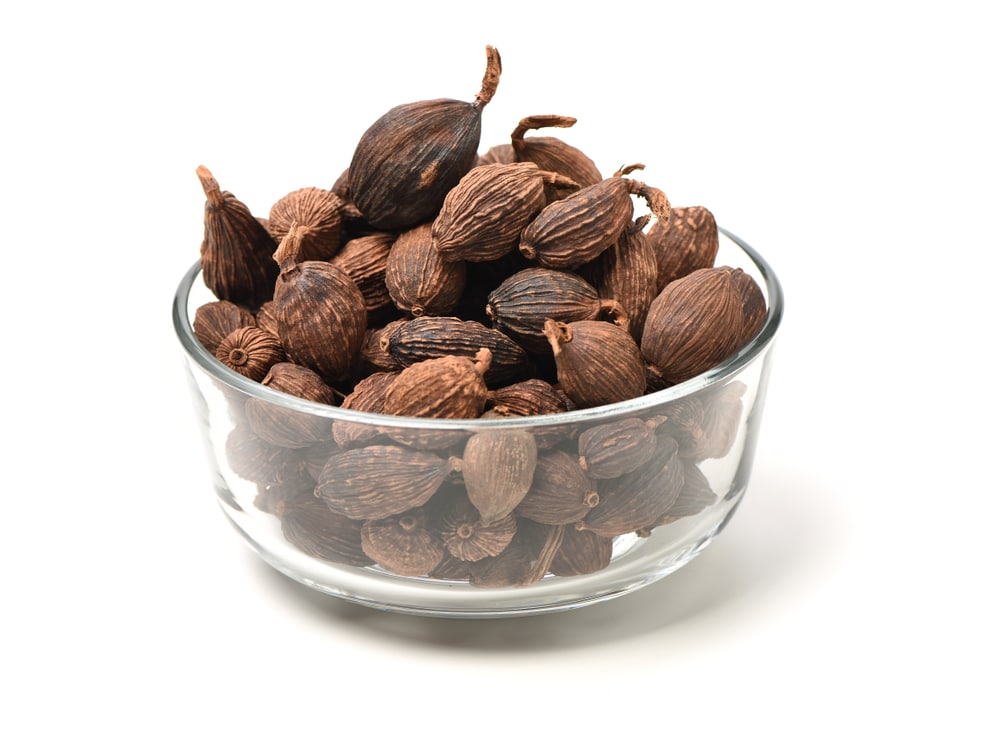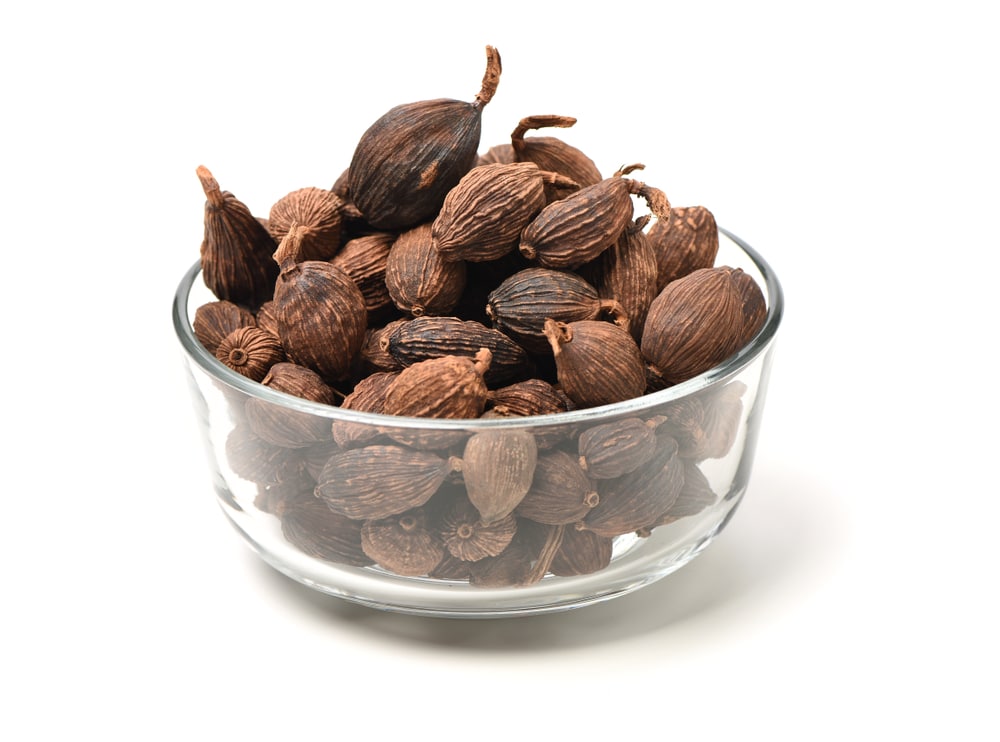Cardamom has been deemed the queen of spices for its aromatic, complex flavors. This spice compliments baked goods and cups of tea perfectly.
Additionally, its unique taste can help temper the heat in savory dishes. Cardamom can also add a warm spice to desserts, like an apple pie, contrasting the sweetness. It is a spice in the ginger family and is native to subtropical Asia, being a recognized ingredient in Indian cuisine.
Cardamom comes in many forms, sold in pods, seeds, and as a powder. But recently, you’ve found a recipe that you want to try out that includes cardamom and are wondering: what’s the difference between cardamom seeds and pods?
Cardamom seeds and pods have several differences that distinguish them, such as their size and shape, but they remain relatively the same with flavor and are very versatile, even extending into uses away from the kitchen.
Cardamom Seeds vs Pods
The main difference between cardamom seeds and pods is the shape and texture. Since they come from the same plant, the flavor is relatively the same. Cardamom pods are trigonal, whereas the seeds are black and small.
Whole pods have clumps of hard, crunchy seeds inside them that can be separated and crushed. It depends on what your recipe calls for, but you can use the pods for full flavor then remove them later, such as steeping one or two in a pot of tea.
- Flavor
- Similar to cumin; it’s used in basmati rice, curries, and marinades.
- Sweet, strong, lemony, and minty; it can be smoky.
- Shelf life
- Ground cardamom is the most perishable, only lasting about three months.
- Seeds will last longer; pods can be stored for at least a year.
- You can purchase cardamom in the spice section of virtually any grocery store.
- Nutritional facts – for a serving size of 1 Tbsp., ground cardamom has:
- 18 calories
- 0g fat
- 65g potassium
- 4g carbohydrates
- 2g fiber
- 1g protein
- Appearance
- The true cardamom (or green cardamom, but we’ll elaborate more on that later) plant has large leaves, white flowers, blue stripes, and yellow borders.
- These plants can grow up to 10 feet in height.
- Cardamom comes from a small fruit containing 8-16 seeds; pods differ in color and size based on species.
- Health benefits
- Cardamom can treat indigestion and help ease asthma.
- Additionally, it has diuretic and antiemetic properties.
- Cardamom is good to treat nausea or motion sickness, as well as remedying pesky hiccups.
- Also, cardamom is a source of limonene, an antioxidant that can prevent cancer.
Comparison Table
| Cardamom Seeds | Cardamom Pods |
| Seeds are removed from pods and then ground. | Typically toasted, fried in a pan with or without oil to extract flavor. Grind or use whole before adding to the recipe. |
| 18-20 seeds | 10 whole pods; black cardamom pods are three times larger than the green. |
| Small and black, resembling peppercorn. | Spindle-shaped, with a triangular cross-section, houses multiple seeds. |
| Adding a few seeds will not overpower spice blends. Seeds have a sweet scent. | Using half a pod will reduce the other spices and make cardamom the lead role in a dish. |
Can You Substitute Cardamom Seeds for Pods?
Ultimately, you can swap cardamom pods with seeds and vice versa, but with a catch.
This spice is popular in Europe, used in loaves of bread, fried in ghee, meat, and vegetable dishes. Cardamom is found in garam masala spice mixture as well. Its warm and nutty flavor with hints of citrus and mint make it an excellent spice for both sweet and savory dishes.
Here are a few considerations to keep in mind. Firstly, different types of cardamom give different flavors. There is white, green, and black cardamom available to purchase. White cardamom is simply bleached green cardamom, giving it less flavor, and is not used nearly as much as the other two. Green, as mentioned previously, is the most common variety and is a top pick for sweet dishes.
It’s important to start with the whole cardamom, even if it takes a little more effort and less convenience. Ground cardamom isn’t as flavorful since essential oils are lost over time in storage. Black cardamom has larger pods that are dark brown and give a smoky, savory element.
It’s recommended to use the whole pod, with the seeds inside, then discard after cooking your dish (since no one wants to bite into a whole pod). Cardamom is good for adding additional flavor to coffee or other beverages.
If you don’t have cardamom seeds or pods, want an alternative flavor, or don’t like the taste cardamom gives, here are a few conversions and substitution recommendations.
- 1 teaspoon ground cardamom seeds equals 18-20 seeds or 10 whole pods
- 1 tablespoon cardamom pods equal 8 grams of ground cardamom
- 10 whole cardamom pods equal ½ teaspoon ground cardamom, or ½ teaspoon cinnamon, or ¼ teaspoon cinnamon plus ¼ teaspoon nutmeg
The majority of the time, pods are used in recipes and kept later for a garnish on top of the dish.
If you are cooking lamb stew, you can replace the cardamom pods with a few sticks of cinnamon and whole cloves. Just remember to remove them before serving.
Allspice powder is ideal for meat and fish dishes that give a similar taste experience to cardamom without needing to add nearly as much.
Fresh, ground, or powdered ginger can be used to replace cardamom in a recipe, too. An entire teaspoon will do the trick, or you can do half-and-half with cinnamon. Cumin and coriander are also suitable mimics of the cardamom flavor, especially in spicy dishes or meat recipes.
What Are Cardamom Seeds?

Cardamom is one of the world’s oldest spices, dating back 4,000 years. Egyptians used it for medicinal purposes or rituals. They even chewed on cardamom pods to keep their breath fresh and teeth clean.
On the other hand, Greeks and Romans used cardamom for its aroma in perfumes and oils. The Vikings first discovered cardamom during their trips, bringing it back to Scandinavia, where it’s still used to this day in recipes. Originally, cardamom grew so lushly in the Western Ghats of Southern India that the area became known as the Cardamom Hills.
Cardamom seeds are found in cardamom pods that grow on plants in Asia. Seeds are completely natural without anything added. You can use cardamom in virtually anything, but it has a distinct flavor that is difficult to replicate.
How to Use Cardamom Seeds
You don’t need as many cardamom seeds to replace other forms of cardamom. For example, you only need ½ teaspoon of cardamom seeds instead of 1 teaspoon of ground cardamom powder. Cardamom is the main component of chai spice blends with its earthy, bittersweet aroma and pairs well with chicken and rice.
What Are Cardamom Pods?

Pods are the homes where the seeds reside and come from identical plants with the same history. Pods are entirely natural and versatile, and you can use the different types of cardamom pods interchangeably.
Furthermore, you can use powdered or ground cardamom to replace pods. Keep in mind that green and white are most used for sweet recipes and not so much for savory.
How to Use Cardamom Pods
The pods are inedible because they’re fibrous, but you don’t need to throw them out, either. Boiling them in water, then straining and cooling gives you an infused, flavored water that’s great for cocktails, lemonade, rice, or curries.
Cardamom has a broad range, utilized from pastries to hamburgers. It’s an autumn-themed flavor, so hot cider, eggnog, or tea would benefit from its characteristics. Lamb is a frequent pairing with cardamom, or you could even make ice cream. Combining the green and black varieties of pods will give you a synced concoction that goes well with vegetables and beans.
They’re super versatile when it comes to being used to freshen living spaces after wrapping them, or creating aromatic oils, in addition to being a natural exfoliator for your skin after adding a bit of honey to the crushed pods.
Remember to keep in mind cardamom has a strong flavor and scent. Therefore, it’s better to start with less and add more if necessary. You don’t want to overpower your tastebuds.







